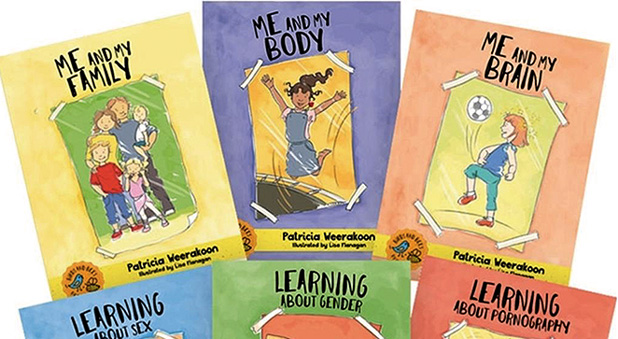Birds and Bees by the Book
by Patricia Weerakoon,
illustrated by Lisa Flanagan
(CEP)
When I saw Patricia Weerakoon had written books for parents to read with children, I couldn’t help but be curious about what they would be like.
They delighted me in some ways and made me squirm in others, but the squirming is possibly my own discomfort with the discussions they are meant to prompt.
Conversations around who we are and how we work are becoming increasingly complicated. Having spent a lot of last year reading books about gender, I’ve dipped my toe into the rabbit hole that is gender conversations. It matters how we have them but we cannot make the mistake of only having them in academic terms – there are real people involved. When we speak about sexuality, gender, and porn especially, we need to have some sort of grounding.
I’m not a parent. I’m a children’s minister. It is not my task to open these books with children, especially considering the sensitive nature of some of the content. But for parents, educating yourself and your children matters. These are written for ages 7-10 but obviously it’s up to your own wisdom about when you would open them up. Let’s not hide our heads in the sand and pretend children aren’t thinking about or experiencing these issues.
It shocks me constantly that these conversations have already begun among children. The average age a child looks at porn is getting younger and younger, and when an Infants’ student can articulate a knowledge of, and hurtful disdain for, a transgender student (as happened in my SRE class), it feels like we’re a little behind. Children are already wading into this water and we’ve got to wade in with them, even if it’s a little cold for our taste.
Weerakoon has done a brilliant job of grounding the books in clear, simple language without dumbing anything down and she constantly brings us back to the Bible. We’re reminded again and again of the gospel, who God is, how he feels about us and how Jesus died to save us from our sins.
There is a page in Thinking about Gender in which she encourages readers to love others even when they’re different to us – to love them like Jesus loves them – and in a climate where truth can mix too easily with exclusion and cruelty, this message matters. It matters that children know their bodies – even the private parts – are good because God made them, but he wants us to use them appropriately.
My one caution is that if your children, or you, are not comfortable with frank language and detail about body parts, sex etc, you’ll find this awkward going. Read the books alone first and make sure the conversations you’re about to have are ones you’re both ready for. Perhaps begin with Me and My Brain and move on to other books later. It doesn’t change my recommendation but please, be wise and do your best to have this moment be prayerful and considered.
If you want to begin to engage – as a parent or as a Christian – but the whole idea seems too hard, these books offer a good foundation for beginning to think and speak about “the birds and the bees” in this complex world.

















